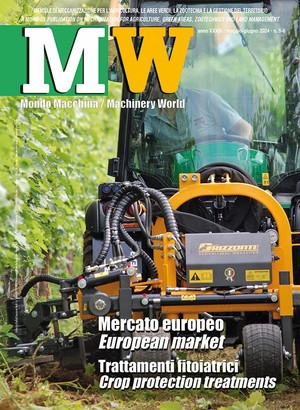
Parking jacks for agricultural equipment: the safety norms
This article describes the functional and structural characteristics of parking jacks for agricultural equipment and illustrates the static and dynamic test procedures to achieve the certification of compliance with safety and reliability requirements laid down by the relevant standard ISO 12140 "Agricultural machinery, agricultural trailers and trailed equipment, drawbar jacks
The frames of the agricultural equipment are normally equipped with a front rudder, to which an extensible parking jack is bound, which in addition to the support function also has that of adjusting the height to allow or facilitate the coupling operations to the tractor.
The jack’s connection to the rudder can be rigid, to maintain only the vertical position, or of a rotary type, with a mechanical safety block, which allows the jack to be placed horizontally to reduce the footprint of the equipment while operating, and the risk of blocking against obstacles on the ground.
The parking jack typical configuration consists of one or more extensions made of coaxial tubular elements, with a typical circular or square section. The movement of the primary extension is carried out continuously, by means of both mechanical drives, with manual control with a crank, or servo drive assisted by an electric gear motor, or of a hydraulic type. The secondary extensions, where provided, are instead adjustable by hand only on certain fixed positions, using a latch with a mechanical safety lock.
The parking jack support base is usually flat and is welded to the end of the last extension or connected through a round torque that allows an angular excursion to adapt the contact to the roughness of the ground. Alternatively, there are parking jacks with a wheeled support base.
Analysis of risks related to the operating and driving of the parking jacks
The U.S. National Institute for Occupational Safety and Health reports 4,000 accidents due to agricultural work, out to approximately two million workers employed in this sector in the United States in 2014. The Institute also reports a mortality rate of 21.4 out of 100,000 workers in the year 2016. The main causes of the accidents analyzed can be traced to transport operations and handling of loads, which have caused hits or accidents due to crushing. The U.K. Health and Safety Executive reports a mortality rate of 12 out of 100,000 workers in the agricultural sector in the EU-28, covering the years 2015-16. Eurostat presents a classification of accident data, not strictly limited to the agricultural sector, which confirms that the risk of crushing due to accidental movement of machinery or loads is among the primary risk sources.
In relation to the danger of crushing, the analysis of the conditions of use of the parking jacks allows to identify the relevance of the risk due to both the proximity of the operator to the equipment during the phases of actuation and regulation of the jack, and the probability that structural collapses occur due to vertical or transverse overloads, or even partial failure due to wear of the screw-nut screw gearing in the mechanical jacks or loss of seal in the hydraulic jacks.
There are mainly three risk reduction strategies. The first aims at designing innovative automatic support systems that can be controlled remotely, so as to reduce the operator exposure to danger. In this regard, the growth of the market in the agricultural sector and the simultaneous need for innovative solutions are very interesting opportunities for investing in research and development in this area. The second strategy is aimed at guaranteeing the structural quality of the parking jacks in terms of mechanical resistance compared to vertical loading and possible transverse loading, due to oscillations, skidding or impact of the equipment. Finally, the third line of action is aimed at ensuring the durability of the jacks and the reliability of the drive system, which must maintain its characteristics of effectiveness and efficiency unchanged over time.
The relevant legislation
The definition of the jack functionality, safety and reliability requirements, and the writing down of the verification and testing procedures are the result of an international technical work that resulted in the ISO 12140 standard, in force since 1998 and that was updated to the second edition in 2013.
The standard is applicable to telescopic jacks, mechanically or hydraulically operated, used with support and lifting functions in equipment and agricultural machinery, and it guarantees its total quality, establishing in a detailed and rigorous way, all the experimental test procedures designed to verify the compliance requirements. As an example, below are described the general specifications of the most significant tests.
Vertical static load test
The jack is fixed to the test machine at maximum extension. The vertical load is applied and gradually increased until it causes a structural collapse.
The purpose of the test is to measure the mechanical resistance to determine the jack mass static vertical flow rate within a 200% safety factor.
Lateral static load test
The jack is fixed at maximum extension. A loading direction is selected and increased the lateral load until it causes structural collapse due to inflection. The test is repeated changing the loading direction in order to identify the critical orientation characterized by the minimum resistance. The jack static lateral flow is determined with a safety factor of 200% compared to the experimentally measured mechanical strength.
Dynamic reliability test
The jack is subjected to a constant over time vertical load with an intensity equal to the dynamic vertical flow that the Manufacturer intends to qualify.
The handle is automatically activated so as to carry out a complete dynamic cycle characterized by the extension to 65% of the useful stroke and a subsequent retraction to the original position.
The handle effort is continuously measured to make sure it remains within the limit set by the legislation. The execution of the dynamic cycle is repeated in such a way as to reach the target of duration, set in a service life of 250 cycles, in order to be able to certify the dynamic vertical flow of the jack.
This type of test is particularly severe and for this reason, it allows to easily select jacks that meet the requirements of robustness and reliability according to ISO 12140.
Tests on specific applications
Handles reproducing the geometry of the specific attachment point are designed, the jack extension is adjusted to the expected value and a static vertical load equal to 200% of the working load is applied. The robustness of the application is also qualified in conjunction with transverse loads, and the test ends with a functional validation, verifying that the jack is able to pass a dynamic reliability test lasting 10 cycles.
The effectiveness of these tests for the purposes of safety certification is underlined by the legislation revising work, currently underway, which divides the ISO 12140 in a first part related to the qualification tests of the jack design, and in a second part, of more specific interest for the manufacturers of agricultural machinery and equipment, dedicated to the qualification tests of the applications.
Conclusions
The ISO 12140:2013 standard specifies the functional, safety and reliability requirements, and the related experimental validation criteria, which allow certifying the total quality of the parking jack through tests of static structural strength and long-lasting functionality.
The certification of conformity is mainly product-oriented: the parking jack, but it can also be extended to specific applications and qualify the actual assembly and operating conditions of each individual agricultural equipment.








